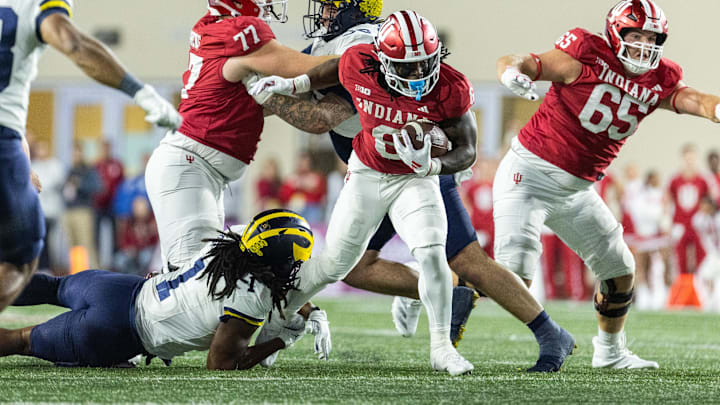Indiana’s Offensive Production: Is There Cause For Concern?

BLOOMINGTON, Ind. – One of the remarkable aspects of Indiana’s 10-0 football season is how easy every win has come but one.
An argument could be made that both Maryland and Northwestern kept it interesting into the fourth quarter, but the Hoosiers ended up winning those games by 14 and 17 points, respectively.
Part of the reason so many of Indiana’s victories came so easily is that the Hoosiers’ offense was clicking on all cylinders. Indiana averaged 512 yards of offense in its first seven games. The Hoosiers had no fewer than 23 first downs or less than four offensive touchdowns scored in any of those first seven contests.
That level of production is what made Indiana’s inability to move the ball in the second half against Michigan such a surprise. The Hoosiers only managed 18 yards of total offense after halftime against the Wolverines. Indiana got the first down it needed late in the game to clinch a 20-15 victory, but it was a hard road otherwise.
The performance didn’t please Indiana coach Curt Cignetti.
“I'm not happy with the way we played, particularly on offense in the second half. So we've got to take a good look at the film Monday and see what happens,” Cignetti said.
Credit was given to a Michigan defense that has a physical front and highly recruited talent, but teams in the College Football Playoff hunt like Oregon (38 points) and Texas (31 points) haven’t had trouble moving the ball on Michigan. In fact, six teams have scored more points against Michigan than Indiana did.
The loss of guard Drew Evans, and the first real disruption to Indiana’s offensive line, may have played a role. It undoubtedly didn’t help the Hoosiers’ cause.
The truth is that what might have been isolated as a one or two-game statistical anomaly has become a trend: Indiana’s offensive production is down over the last three contests.
Starting with Indiana’s 31-17 victory against Washington on Oct. 26, Indiana has averaged 314.3 yards per game, almost 200 yards less than the Hoosiers averaged in their first seven games. If Indiana had averaged 314.3 yards per game over the whole season, the Hoosiers would rank 123rd nationally.
Naturally, totals are down across the board. After passing for 300 or more yards in four of the first seven games, Indiana’s highest total since is 263. Indiana rushed for an impressive 188 yards against Washington, but the rushing averages in the last three games – 3.6, 3.8 and 1.4 – are well off Indiana’s season average of 4.7 yards per carry.
Indiana’s three lowest single-game first down totals have all been in the last three contests. The Hoosiers have not had more than 20 in that stretch.
Why are Indiana’s numbers down? In the Washington game, backup quarterback Tayven Jackson played in place of starting quarterback Kurtis Rourke. The Hoosiers leaned on the run game (Justice Ellison primarily) and weren’t as balanced as they had been previously, with 52 runs plays to 19 pass plays. So a conservative approach may explain the numbers in that specific contest.
The temptation to cite Rourke’s thumb injury as a cause for lower numbers is there, but may not stand up to scrutiny. Rourke’s completion percentages since his return have been 65.5% and 60.7%, less than his season average of 71.8%, but not dramatically so. Rourke himself said his thumb is not affecting his ability to throw.
Indiana was hampered by other injuries on Saturday besides Evans. Myles Price was injured in the first half and didn't return. Justice Ellison was injured and did return, but was not productive.
Part of Indiana’s lower numbers is explained more simply: Indiana is playing better teams. Washington and Michigan both have solid defenses. Michigan State ultimately gave in against the Hoosiers after a strong defensive start.
Time will tell whether Indiana’s declining offensive numbers become or even are a problem for the Hoosiers.
An uptick in numbers would be very encouraging against Indiana’s next opponent – Ohio State – but it won’t be easy. The Buckeyes have only given up more than 300 yards of total offense once this season when it conceded 496 yards in its 32-31 loss at Oregon on Oct. 12.
Related stories on Indiana football
- INDIANA MOVES TO NO. 5: Hoosiers move up three spots in latest AP football poll. CLICK HERE.
- PREDICTIONS REVISITED: How did Hoosiers On SI do on our pregame keys and predictions? Find out. CLICK HERE.
- INDIANA ESCAPES WITH 20-15 WIN: Indiana holds off Michigan to earn a 20-15 win to improve to 10-0. CLICK HERE.
- FEAR NOT, THE DEFENSE HAS THIS: Todd Golden writes about how it got a bit scary at Memorial Stadium on Saturday ... until the Indiana defense got on the field. CLICK HERE.
- WHAT CIGNETTI SAID: Here's everything Cignetti said to the media after the Michigan win. CLICK HERE
- ROLES REVERSED FOR MICHIGAN: Indiana rarely loses to Michigan, but the roles are reversed as Indiana improved to 10-0 at the expense of the Wolverines. CLICK HERE.
